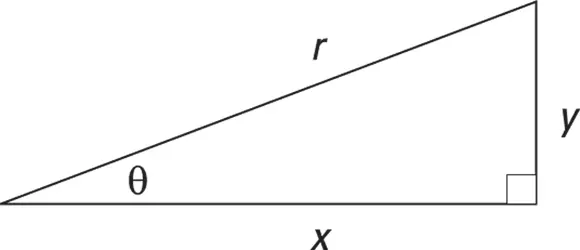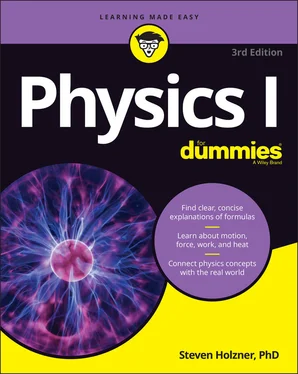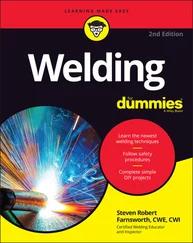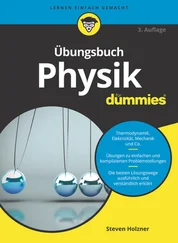1 ...7 8 9 11 12 13 ...18 You need to be able to isolate different variables. For instance, the following equation tells you the distance, s , that an object travels if it starts from rest and accelerates at rate of a for a time, t:

Now suppose the problem actually tells you the time the object is in motion and the distance it travels and asks you to calculate the object’s acceleration. By rearranging the equation algebraically, you can solve for the acceleration:

In this case, you’ve multiplied both sides by 2 and divided both sides by t 2to isolate the acceleration, a , on one side of the equation.
What if you have to solve for the time, t ? By moving the number and variables around, you get the following equation:

Do you need to memorize all three of these variations on the same equation? Certainly not. You just memorize one equation that relates these three items — distance, acceleration, and time — and then rearrange the equation as needed. (If you need a review of algebra, get a copy of Algebra I For Dummies by Mary Jane Sterling [Wiley].)
You need to know a little trigonometry, including the sine, cosine, and tangent functions, for physics problems. To find these values, start with a simple right triangle. Take a look at Figure 2-1, which displays a right triangle in all its glory, complete with labels we’ve provided for the sake of explanation. Note in particular the angle  , which appears between one of the triangle’s legs and the hypotenuse (the longest side, which is opposite the right angle). The side y is opposite
, which appears between one of the triangle’s legs and the hypotenuse (the longest side, which is opposite the right angle). The side y is opposite  , and the side x is adjacent to
, and the side x is adjacent to  .
.

FIGURE 2-1: A labeled triangle that you can use to find trig values.
 To find the trigonometric values of the triangle in Figure 2-1, you divide one side by another. Here are the definitions of sine, cosine, and tangent:
To find the trigonometric values of the triangle in Figure 2-1, you divide one side by another. Here are the definitions of sine, cosine, and tangent:
If you’re given the measure of one angle and one side of the triangle, you can find all the other sides. Here are some other forms of the trig relationships — they’ll probably become distressingly familiar before you finish any physics course, but you don’t need to memorize them. If you know the preceding sine, cosine, and tangent equations, you can derive the following ones as needed:
To find the angle  , you can go backward with the inverse sine, cosine, and tangent, which are written as sin –1, cos –1, and tan –1. Basically, if you input the sine of an angle into the sin –1equation, you end up with the measure of the angle itself. Here are the inverses for the triangle in Figure 2-1:
, you can go backward with the inverse sine, cosine, and tangent, which are written as sin –1, cos –1, and tan –1. Basically, if you input the sine of an angle into the sin –1equation, you end up with the measure of the angle itself. Here are the inverses for the triangle in Figure 2-1:
If you need a more in-depth refresher, check out Trigonometry For Dummies, by Mary Jane Sterling (Wiley).
Interpreting Equations as Real-World Ideas
Physics instructors are very familiar with one of the biggest problems college students face — getting lost in, and being intimidated by, the math.
 Always keep in mind that the real world comes first and the math comes later. When you face a physics problem, make sure that you don’t get lost in the math; keep a global perspective about what’s going on in the problem, because doing so helps you stay in control.
Always keep in mind that the real world comes first and the math comes later. When you face a physics problem, make sure that you don’t get lost in the math; keep a global perspective about what’s going on in the problem, because doing so helps you stay in control.
BE A GENIUS: DON’T FOCUS ON THE MATH
Richard Feynman was a famous Nobel Prize winner in physics who had a reputation during the 1950s and ’60s of being an amazing genius. He later explained his method: He attached the problem at hand to a real-life scenario, creating a mental image, while others got caught in the math. When someone would show him a long derivation that had gone wrong, for example, he’d think of some physical phenomenon that the derivation was supposed to explain. As he followed along, he’d get to the point where he suddenly realized the derivation no longer matched what happened in the real world, and he’d say, “No, that’s the problem.” He was always right, which mystified people who, awestruck, took him for a supergenius. Want to be a supergenius? Do the same thing: Don’t let the math scare you.
In physics, the ideas and observations of the physical world are the things that are important. Math operations are really only a simplified language for accurately describing what is going on. For example, here’s a simple equation for speed:

In this equation, v is the speed, s is the distance, and t is the time. You can examine this equation’s terms to see how this equation embodies simple common-sense notions of speed. Say that you travel a larger distance in the same amount of time. In that case, the right side of the equation must be larger, which means that your speed, on the left, is also greater. If you travel the same distance but it takes you more time, then the right side of this equation becomes smaller, which means that your speed is lower. The relationship between all the different components makes sense.
You can think of all the equations you come across in a similar way to make sure they make sense in the real world. If your equation behaves in a way that doesn’t make physical sense, then you know that something must be wrong with the equation.
Bottom line: In physics, math is your friend. You don’t need to get lost in it. Instead, you use it to formulate the problem and help guide you in its solution. Alone, each of these mathematical operations is very simple, but when you put them together, they’re very powerful.
Chapter 3
Exploring the Need for Speed
IN THIS CHAPTER
 Getting up to speed on displacement
Getting up to speed on displacement
 Dissecting different kinds of speed
Dissecting different kinds of speed
 Going with acceleration
Going with acceleration
 Examining the link among acceleration, time, and displacement
Examining the link among acceleration, time, and displacement
Читать дальше




 , which appears between one of the triangle’s legs and the hypotenuse (the longest side, which is opposite the right angle). The side y is opposite
, which appears between one of the triangle’s legs and the hypotenuse (the longest side, which is opposite the right angle). The side y is opposite  , and the side x is adjacent to
, and the side x is adjacent to  .
.
 To find the trigonometric values of the triangle in Figure 2-1, you divide one side by another. Here are the definitions of sine, cosine, and tangent:
To find the trigonometric values of the triangle in Figure 2-1, you divide one side by another. Here are the definitions of sine, cosine, and tangent: , you can go backward with the inverse sine, cosine, and tangent, which are written as sin –1, cos –1, and tan –1. Basically, if you input the sine of an angle into the sin –1equation, you end up with the measure of the angle itself. Here are the inverses for the triangle in Figure 2-1:
, you can go backward with the inverse sine, cosine, and tangent, which are written as sin –1, cos –1, and tan –1. Basically, if you input the sine of an angle into the sin –1equation, you end up with the measure of the angle itself. Here are the inverses for the triangle in Figure 2-1: Always keep in mind that the real world comes first and the math comes later. When you face a physics problem, make sure that you don’t get lost in the math; keep a global perspective about what’s going on in the problem, because doing so helps you stay in control.
Always keep in mind that the real world comes first and the math comes later. When you face a physics problem, make sure that you don’t get lost in the math; keep a global perspective about what’s going on in the problem, because doing so helps you stay in control.
 Getting up to speed on displacement
Getting up to speed on displacement










